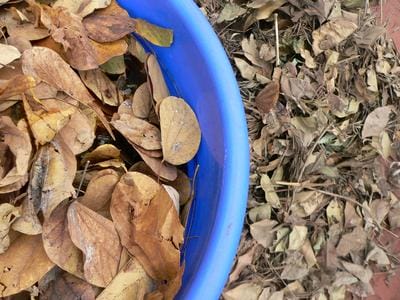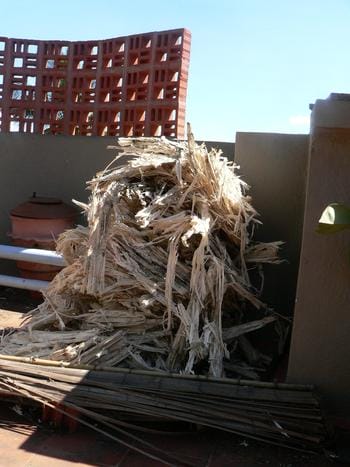For a BBMP pourakarmika, this would perhaps rank as the worst time of the year as s/he would be constantly required to sweep the streets. Those in independent houses with a garden and trees would be filling the leaves in several black garbage bags everyday, perhaps even having to pay a little something to have it cleared. As apartment dwellers, leaves shed from the tree probably do not feature as easily on our radar. But if you are trying to learn all things related to creating and managing a healthy terrace garden, like me, you would rush to collect and store this rich resource.

Mulching improves the soil quality. Pic: Vinita
In forests, tree leaves and other organic waste form a natural cover over the soil surface. This not only conserves moisture and controls temperatures but also prevents soil erosion and crusting. Over time bacteria, fungi and other microbes decompose the leaves and other organic matter, slowly releasing nutrients to the plants.
In the garden, mulching has the same effect. Derived from a German word molsch, meaning ‘soft’ or ‘beginning of decay’, mulching merely refers to applying a protective covering on the soil surface.
How does mulching work?
Dry leaves, bagasse, straw and other such easily available materials are most useful as organic mulches. As they decompose, they release humic acids into the soil that help to effectively bind soil particles together and prevent erosion. In addition, the decomposition also add add nutrients to the soil. When turned into soil, this additional organic matter improves the overall water-retention capacity, nutrient availability and aeration; and simultaneously conditions the soil.
Mulching is not a one-time process. It certainly requires a little planning and care, needing to be done periodically; but the effort is well worth it. After all, it is only healthy soil that can ensure healthy plants. And it is good to remember that most of the work involved in mulching involves collecting the material.
Mulching in terrace gardens
Mulching is certainly required for terrace gardens. In fact all soil that is used for planting ought to be mulched to improve its health and therefore the health of the plants. Mulching is possible in pots and containers and is simple enough to start almost immediately.
The first step would be to scout your neighbourhood and collect enough material for mulch. And are we not in luck? Look around. The easiest way I have discovered is to befriend a BBMP pourakarmika and a local sugarcane juice vendor and arm them with a sack; they are quite willing to share the collected materials.

Sugarcane vendor can be a great resource. Pic: Vinita
How to mulch?
Once collected, the leaves/bagasse should be sun-dried and the leaves crushed by stepping on them. Those with lawn mowers or shredders could use it to hasten the process. After watering the soil well, the organic mulch can be spread to a depth of about 3-5 inches, leaving about 2 inches around the stem of the plant to avoid stem rot. Remember mulching is for the soil not the plant. In the case of seedlings, it is good to wait till they are about 4-6 inches tall before mulching around them. You can arrange the mulch as a carpet all around as I observed at the interesting ancestral home of Mr Arun (of Red Sanders) or you can choose to make concentric rings around the base of the plant stem.
Easily available Organic Mulches
Dry leaves – easily collected from trees in the neighbourhood –
Bagasse – contact your nearest sugarcane juice vendor
Straw – the fruit vendors have a lot of it these days – for apples and oranges!
Compost – from your kitchen waste
Having mulched the soil in your garden, you will notice that the need to water will reduce significantly. A boon, during the upcoming summer months. And when you notice the mulch has started decomposing, you’ll know its time to replace it at the earliest.
So, compliments of the season – make the most of it. Among other things, resolve to collect the leaves from at least one tree all through this season and use it to mulch your garden or plants and trees in your neighbourhood.
Useful links
![]() How to mulch a vegetable garden
How to mulch a vegetable garden
This video shows the use of newspaper as mulch, which one needs to be wary of (due to the ink used); however it is useful to understand the ‘how’ of it.
![]() Save your Leaves
Save your Leaves
A Daily Dump film that is best viewed as a community so go ahead and arrange a screening in your apartment/neighbourhood or office. Who knows – it might inspire the children in your area or your office colleagues to join you in a unique collection drive!⊕